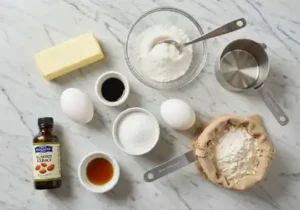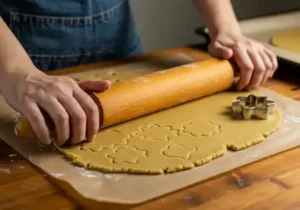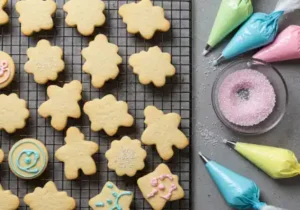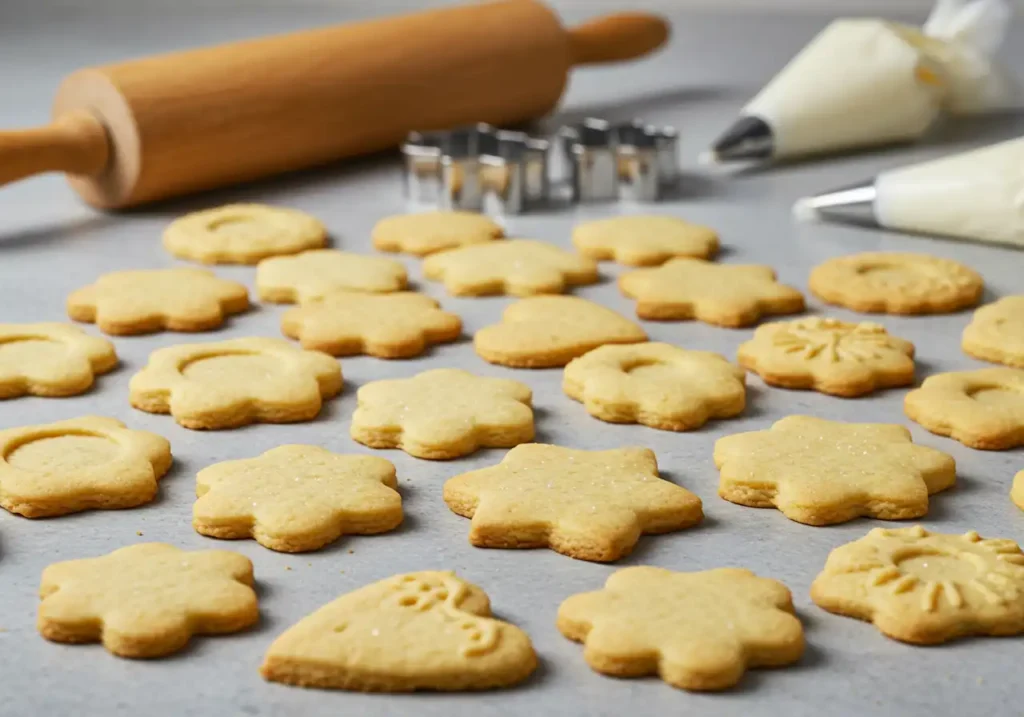Having the best sugar cookie recipe for perfect cut-outs every time is essential for holiday baking or any special occasion. A reliable sugar cookie recipe ensures that your cookies hold their shape, have a tender texture, and are easy to decorate.
Sugar cookies are ideal for shaping and decorating due to their balanced mix of softness and structure. The dough is sturdy enough to withstand the rolling and cutting process without falling apart, yet it bakes into a delicate, melt-in-your-mouth treat. The flat surface of a well-made sugar cookie provides the perfect canvas for creative decoration, making it a favorite among bakers.
This article aims to share the best sugar cookie recipe along with techniques for achieving flawless cut-out cookies every time. From choosing the right ingredients to mastering key dough techniques, you’ll learn how to create beautifully shaped and deliciously soft sugar cookies that are perfect for any occasion. Whether you’re an experienced baker or just starting out, these tips will help you achieve consistent results and elevate your cookie-baking game.
Essential Ingredients for Perfect Sugar Cookies
 Choosing the right sugar cookie ingredients sets the foundation for flawless cut-outs every time. Each element in the mix has a purpose, from texture to flavor balance.
Choosing the right sugar cookie ingredients sets the foundation for flawless cut-outs every time. Each element in the mix has a purpose, from texture to flavor balance.
Butter: The debate between unsalted and salted butter is ongoing, but for control over salt content and clean flavor, unsalted butter wins out. It produces cookies with a tender crumb and rich mouthfeel. Salted butter adds complexity but can be inconsistent from brand to brand—stick with unsalted if precision matters.
Sugar: Granulated sugar remains the top pick for classic sugar cookies. The fine crystals cream smoothly with butter, creating a light texture that holds its shape well. Organic cane sugar works too, bringing subtle molasses notes and a slightly coarser grind, but it may change the color or spread of your cookies.
Eggs: Fresh eggs at room temperature blend seamlessly into the dough, ensuring even structure. Cold eggs can cause butter to seize up, while older eggs may introduce unwanted moisture or off flavors. Room-temperature eggs provide a consistent rise and keep cookies tender inside.
Flavor Enhancers: Pure vanilla extract is non-negotiable for authentic aroma and warmth; imitation varieties fall flat in comparison. Almond extract is an optional upgrade—just a splash transforms basic dough into something bakery-worthy without overpowering other flavors.
Flour: All-purpose flour delivers the essential structure for cut-out cookies. Too much flour leads to dry, tough cookies; too little risks spreading and misshapen edges. Weighing flour or spooning it into your measuring cup prevents heaviness and maintains a smooth, workable dough in every batch.
“Every ingredient earns its place in this recipe—focus on quality and proper ratios to achieve sugar cookies that are as beautiful as they are delicious.”
For those looking to experiment beyond traditional recipes, consider trying out a soft and chewy chocolate chip cookie recipe or exploring unique flavor profiles with buttermilk cake, which could inspire new twists on your sugar cookie creations.
Key Techniques to Achieve Ideal Cookie Dough
Achieving the perfect sugar cookie dough involves precise techniques that ensure your cookies hold their shape and have the ideal texture.
-
Step-by-Step Creaming of Butter and Sugar
Start by thoroughly creaming the butter and sugar. This process involves beating them together until the mixture is light and fluffy. This step is crucial as it creates a smooth base and incorporates air, which helps the cookies rise slightly during baking.
-
Incorporating Eggs and Extracts Correctly After Creaming
Once the butter and sugar are creamed, add eggs one at a time, mixing well after each addition. Incorporate vanilla extract (and optional almond extract) at this stage to evenly distribute the flavors throughout the dough.
-
Combining Dry Ingredients Separately Before Mixing
Mix dry ingredients such as flour, baking powder, and salt in a separate bowl. Gradually add these to the wet mixture. This method prevents overworking the dough, which can lead to tough cookies.
-
Chilling Dough Duration and Benefits
Chill the dough for at least 1-2 hours or overnight. Chilling firms up the dough, making it easier to roll out without sticking. It also helps maintain shape during baking by preventing excessive spreading.
-
Rolling Dough Between Parchment Paper
 Roll out the dough between two sheets of parchment paper. This technique prevents sticking without adding extra flour, which could alter the dough’s consistency. Aim for an even thickness, typically around 1/4 inch to 3/8 inch, ensuring uniform baking.
Roll out the dough between two sheets of parchment paper. This technique prevents sticking without adding extra flour, which could alter the dough’s consistency. Aim for an even thickness, typically around 1/4 inch to 3/8 inch, ensuring uniform baking.
By following these steps—creaming your butter and sugar properly, incorporating eggs and extracts correctly, combining dry ingredients separately, chilling your dough adequately, and rolling it out between parchment—you set yourself up for success in creating perfectly shaped sugar cookies every time.
Shaping, Baking, and Decorating Tips for Perfect Cut-Outs
Consistent results start with rolling your sugar cookie dough to the right thickness. Aim for 1/4 inch to 3/8 inch—this range keeps shapes defined during baking, prevents warping, and supports decorations. Thinner dough can lead to crisp, fragile cookies that brown too quickly; thicker dough risks underbaking at the center.
Shaping and Sheet Placement
- Use sturdy metal cookie cutters for clean lines and sharp details.
- Dip cutters in flour, then stamp out shapes as close together as possible to minimize re-rolling scraps.
- Place cut-outs at least 1 inch apart on a parchment-lined baking sheet. This spacing ensures proper airflow so edges stay crisp and cookies don’t merge.
Baking Temperature and Timing
- Bake at 350°F (175°C) for even cooking. The best sugar cookie recipe for perfect cut-outs every time delivers cookies that are just set and slightly puffed without browning—usually 8–11 minutes.
- Remove from the oven once the edges look matte but not golden. Overbaking toughens the texture and dulls the flavor.
Cooling Process
- Allow cookies to cool on the baking sheet for 5–10 minutes; they set up and finish cooking gently from residual heat.
- Transfer carefully to wire racks using a spatula for complete cooling before decorating.
Decorating Options

- Frost before or after baking: Sprinkle with sanding sugar pre-bake for sparkle or decorate post-bake with icing or glaze.
- Royal Icing: Yields a smooth, hard finish—ideal for detailed designs and stacking cookies.
- Buttercream Frosting: Soft and creamy, great for swirls and spreading; less durable if you need to stack or transport.
- Glaze: Shiny and quick-drying, easy for simple coverage.
Gel Food Coloring
Opt for gel food coloring when tinting royal icing or buttercream. It provides deep, vibrant hues without thinning your frosting—crucial for precise piping work on shaped cookies.
The combination of these techniques makes your cookie recipe stand out in both flavor and presentation.
Storage, Dough Preservation, and Troubleshooting Tips for Cut-Out Sugar Cookies
Proper storage and dough preservation techniques make a significant difference in the freshness and quality of your cut-out sugar cookies. Using airtight containers is key. Line each layer of cookies with parchment paper—this prevents sticking and preserves intricate decorations. Well-stored decorated cookies retain their flavor and crisp edges for up to two weeks at room temperature.
Freezing Cookie Dough
When it comes to freezing cookie dough, flexibility is built into the process:
- Freeze unbaked dough as flat discs, double-wrapped in plastic wrap and sealed in a zip-top bag. This method protects against freezer burn and makes future rolling easier.
- Pre-cut shapes can also be frozen on a baking sheet until solid, then transferred to airtight containers or bags with parchment between layers. Thaw in the refrigerator before baking to maintain clean edges and proper shape.
Chilling for Shape Maintenance
Maintaining shape during baking starts well before the oven. Chilling the dough after mixing—and again after cutting shapes—ensures cookies don’t spread excessively. For best results, chill for at least an hour, or overnight if possible.
Avoiding Tough Cookies
Tough cookies often indicate overworked dough. Mixing just until combined will yield a more tender bite. Resist the urge to add excess flour during rolling; use parchment paper instead.
Troubleshooting Tips
If cookies lose their sharp edges or look puffy, try these quick troubleshooting tips:
- Slightly increase the flour by 1–2 tablespoons if the dough feels too soft.
- Extend chilling time before cutting or baking.
- Check oven temperature accuracy with an oven thermometer.
Small adjustments make a big impact on both texture and appearance, helping you achieve consistently perfect cut-outs every time.
Conclusion
You can make perfect sugar cookies every time. By following the proven techniques and ingredient guidelines in this guide, you can expect consistent results in baking cut-outs—from crisp edges to tender centers and flawless shapes. The Best Sugar Cookie Recipe for Perfect Cut-Outs Every Time isn’t just about ingredients; it’s about process, patience, and precision.
- Trust the chilling step for shape retention
- Roll evenly for uniform baking
- Store with care for lasting freshness
Use these expert tips and watch your sugar cookie creations impress at every celebration.

